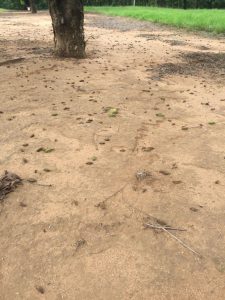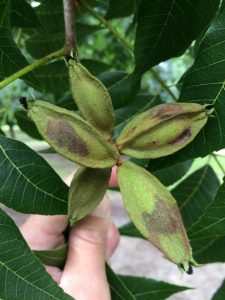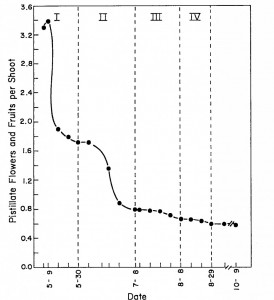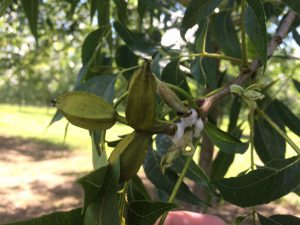We have seen a fairly large Pawnee drop over the last week. It is not uncommon for Pawnee to shed a few nuts this time of year but this year’s drop looks a little heavier in places. Still, I don’t think its anything much to worry about in most cases. Most of the Pawnee trees I have seen with a heavy drop under them still have a heavy crop on them. The drop probably helped them more than hurt them. The trees should be able to produce better quality and have a better chance of a return crop.
Aborted Pawnee nuts prior to drop
Stages of Pecan Nut Drop (Sparks and Madden, 1985)
As the graph above shows, pecans undergo 4 separate fruit drops during the growing season, most of which are related to pollination problems. Pawnee is about a month ahead of most of our other varieties, so this drop would coincide with the 3rd drop in the graph above (which is based on Desirable). This drop occurs just before rapid fruit expansion and is due to the failure of the endosperm to develop properly. This drop is known to be accentuated by self-pollination. The low chill hours of this past winter and the resulting effect on budbreak (see previous post) could have affected cross pollination, leading to more self-pollination. If so, we may see a similar drop on other varieties in a few weeks.
Spittlebug mass
Spittlebugs have been active this year and can be seen on trees throughout the state, sometimes in large numbers. The mass of spittle hides and protects the spittlebugs which are feeding on the sap of the trees. While you may see large numbers of these spittlebug masses on the trees, they generally do not cause any economic harm. I have seen orchards with high spittlebug populations go unsprayed with no effect on the trees or crop. If growers do choose to spray for them, imidacloprid will control the spittlebugs. Most aphid materials will get spittlebugs as well when you spray for aphids.




